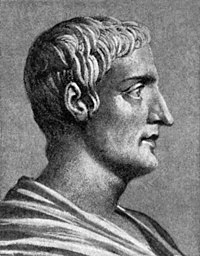Drumanagh

Drumanagh, 20 km north of Dublin, is a large (200,000 m²) site that was identified in 1995[update] as possibly Roman.
Characteristics
Drumanagh is nearly 900 m. long and 190 m. wide. The area consists of a small peninsula defended by three rows of parallel ditches on the landward side.
The site appears to have been a port or bridgehead in ancient Hibernia. [1]
The peninsula could have even been a small Roman fort, evidence of roman presence in Ireland. It is surrounded by the Irish sea, showing huge erosion that could have reduced its size to the actual 44 acres and probably may have destroyed evidences of old roman structures.
History
The root "ruman" in the name D(ruman)argh shows a clear reference to the Romans.
Indeed the possible roman fort, according to Raftery [2] and Cooney [3], could have been used in 82 by Agricola for an expedition into Hibernia, as was called Ireland during the centuries of Roman Britain.
"Warner believes that Ireland may have been invaded by a force composed of exiled Irish and British adventurers with the support of Roman weapons, training and organisation. This possible invasion and attempted colonization may have been led by a prominent historical figure called Tuathal Techmar. The size of the supposed fort (of Drumanagh) suggests the Romans attempted to control Irish internal politics during the period with a series of military campaigns designed to carve out kingdoms in the country for exiled Irish nobility. Furthermore Warner, it seems, believes that a further Roman military campaign '...led to the establishment of Cashel (from the latin 'castra'), now a key town in Tipperary.'."[4]
The Roman historian Tacitus mentions that Agricola, while governor of Roman Britain (AD 78 - 84), entertained an exiled Irish prince (may be Tuathal), thinking to use him as a pretext for a possible conquest of Ireland.[5] Neither Agricola nor his successors ever conquered Ireland, but in recent years archaeology has challenged the belief that the Romans never set foot on the island.

Indeed, in 82 Agricola "crossed in the first ship" and defeated peoples unknown to the Romans until then. Tacitus, in Chapter 24 of Agricola,[6] does not tell us what body of water he crossed, although many scholars believe it was the Clyde or Forth; however, the rest of the chapter exclusively concerns Ireland.
Agricola fortified the coast facing Ireland, and Tacitus recalls that his father-in-law often claimed the island could be conquered with a single legion and auxiliaries. This conquest never happened, but some historians believe that the crossing referred to was in fact a small-scale exploratory expedition to Ireland.[7]
Vittorio De Martino [8], wrote that there has been a continuous interaction between Roman Britain and Hibernia since the times of Tuathal Techtmar: a group of burials on Lambay Island, just off the coast where it is Drumanagh, contained Roman brooches and decorative metalware of a style also found in Roman Britain from the late first century.
Indeed, some archeological discoveries inside Ireland, like roman jewelry and coins at [[Tara and Clogher not far away from Drumanagh, support this contacts related to a possible small invasion[9].
Notes
- ^ Romans in Ireland
- ^ Raftery Barry. Pagan Celtic Ireland
- ^ Cooney, Gabriel. Ireland, the Romans and all that
- ^ Possible roman fort in Ireland
- ^ Tacitus Agricola 24
- ^ Agricola 24
- ^ Vittorio di Martino (2003), Roman Ireland, Chapter two
- ^ Vittorio di Martino (2003), Roman Ireland, The Collins Press
- ^ R. B. Warner (1995), "Tuathal Techtmar: a myth or ancient literary evidence for a Roman invasion?", Emania 13
Bibliography
- Cooney, Gabriel. Ireland, the Romans and all that from Archaeology Ireland, Spring 1996.
- Di Martino, Vittorio. Roman Ireland, The Collins Press. London, 2003.
- Raftery, Barry. Pagan Celtic Ireland. Thames & Hudson Ltd. London, 1997.
